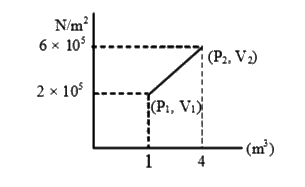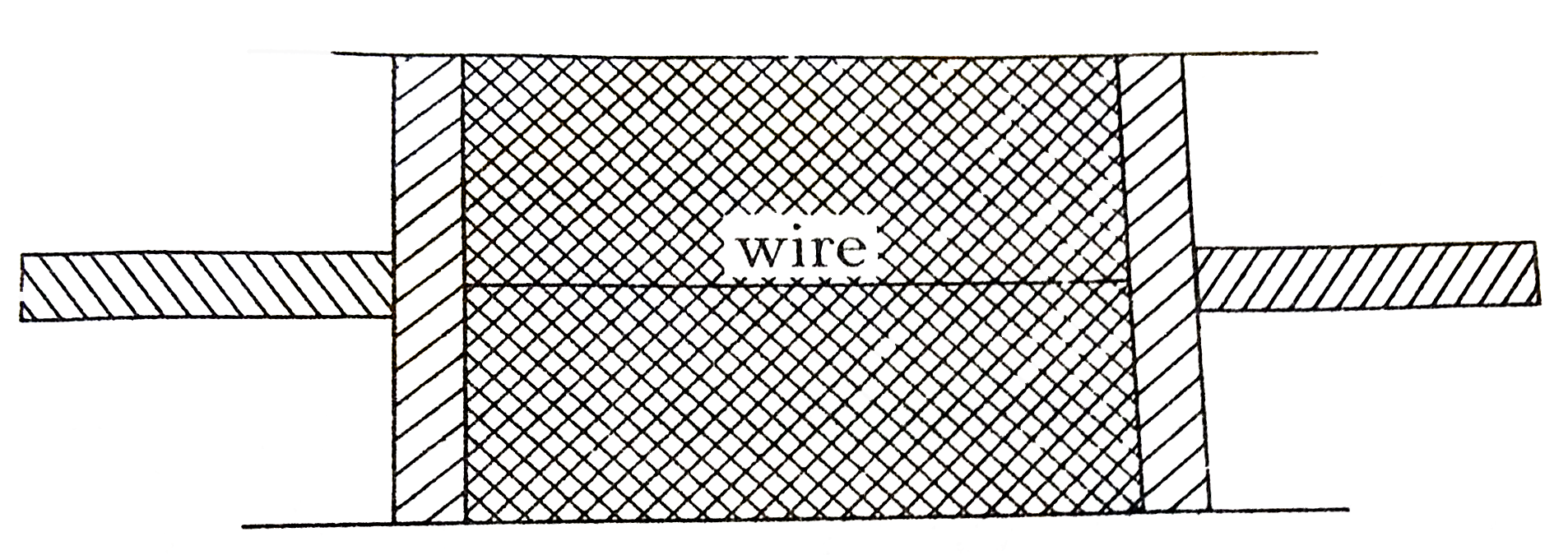Consider a cycle tyre being filled with air by a pump. Let V be the volume of the tyre (fixed) and at each stroke of the pump ΔV(<<V) of air is transferred to the tube adiabatically . What is the work done when the pressure in the tube is increased from P1→P2?
If ΔP is small increase in pressure of air, when volume of air increases by a small amount ΔV, then as the change in adiabatic, P(V+ΔV)γ=(P+ΔP)Vγ
PVγ(1+ΔVV)γ=P(1+ΔPP)Vγ or 1+γΔVV=1+ΔPP
or γΔVV=ΔPP or ΔV=1γVPΔP or dV=VγPdp ....(i)
Work done in increasing the pressure from P1→P2
W=∫P2P1PdV
Using (i),
W=∫P2P1PVγPdp=Vγ(P2−P1)
Topper's Solved these Questions
- THERMODYNAMICSBook:PRADEEPChapter:THERMODYNAMICSExercise:Long answer questions(NCERT)
Explore 5 Videos
- THERMODYNAMICSBook:PRADEEPChapter:THERMODYNAMICSExercise:Higher order thinking skills
Explore 9 Videos
- THERMODYNAMICSBook:PRADEEPChapter:THERMODYNAMICSExercise:Very short answer questions(NCERT)
Explore 5 Videos
- SYSTEMS OF PARTICLES AND ROTATIONAL MOTIONBook:PRADEEPChapter:SYSTEMS OF PARTICLES AND ROTATIONAL MOTIONExercise:Assertion- Reason Type questions
Explore 20 Videos
- WORK, ENERGY AND POWERBook:PRADEEPChapter:WORK, ENERGY AND POWERExercise:Assertion-Reason Type Questions
Explore 24 Videos
Similar Questions
Consider a cycle tyre being filled with air by a pump. Let V be the volume of the tyre (fixed) and at each stroke of the pump ΔV(<<V) of air is transferred to the tube adiabatically. What is the work done when the pressure in the tube is increased from p1 to p2 ?
View SolutionWhen air is pumped into a cycle tyre, the volume and pressure of the air in the tyre, both are increased.
What about Boyle's law in this case?
View Solution
Knowledge Check
A system changes from the state (P1,V1) to (P2,V2) as shown in the figure below. What is the work done by the system –
 A7.5×105 jouleB7.5×104 ergC12×105 jouleD6×105 joule
A7.5×105 jouleB7.5×104 ergC12×105 jouleD6×105 joulePressure P, volume V and temperature T for a certain gas are related by P=AT−BT2V, where A and B are constants .The work done by the gas as its temperature change from T1 to T2 while pressure remaining constant is
AA−B2(T2−T1)BA(T2−T1)−B(T22−T21)CA2(T22−T21)−B3(T32−T31)DA(T2−T1)2=B3(T2−T1)3A cylindrical tube of uniform cross-sectional area A is fitted with two air tight frictionless postion.
 The pistons are connected to each other by a metallic wirte. Initially the pressure of the gas is po and temperature is To, atmospheric pressure is also po Now the temperature of the gas is increased to 2T0, the tension in the wire will be A2poABpoACpoA2DpoA
The pistons are connected to each other by a metallic wirte. Initially the pressure of the gas is po and temperature is To, atmospheric pressure is also po Now the temperature of the gas is increased to 2T0, the tension in the wire will be A2poABpoACpoA2DpoA
When air is pumped into a cycle tyre the volume and pressure of the air in the tyre both are increased. What about Bouyle's law in this case?
View SolutionA vacuum pump has a cylinder of volume upsilon and is connected to a vessel of volume V to pump out air from the vessel The initial pressure of gas in vessel is P Show that after n strockes the pressure in vessel is reduced to
Pn=P[VV+v]n .
View SolutionIn a tyre of "Ferrari" car of Mr. Obama, a tube having a volume of 12.3 litres is filled with air at a pressure of 4 atm at 300 K.Due to travelling, the temperature of the tube and air inside it raised to 360 K and pressure reduced to 3.6 atm in 20 minutes. If the porosity (number of pores per unit area) of the tube material is 5×103 pores/cm2 and each pore can transfer air from inside to outside of the tube with the rate of 6.023×108 molecules per minute.Calculate the total surface area (m2) of the tube.(R=0.082 Lt-atm/mole-K)
Give your answer divide by 100.
View SolutionConsider one mole of helium gas enclosed in a container at initial pressure P1and volume V1 . It expands isothermally to volume V1 After this , the gas expands adiabatically and its volume becomes 32V1 . The work done by the gas during isothermal and adiabatic expansion processes are WisoandWadia respectively . if the radio WisoWadia=fIn2, then f is __________ .
View SolutionTwo thermally insulated vessels 1 and 2 are filled with air and connected by a short tube equipped with a valve. The volumes of the vessels, the pressures and temperatues of air in them are V1,p1,T1 and V2,p2,T2, respectively. Find the air temperature and pressure after the opening of the valve.
View Solution